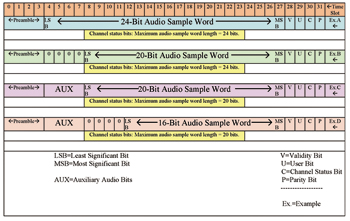Decoding Timeslots For AES3, Part 4

There are a few more parts of the AES3 bitstream that still need to be discussed—the timeslots for the digital audio signal, as well as the user and channel status bits.
As a reminder, each AES3 frame is divided into two subframes, and each subframe is divided into 32 timeslots, numbered from zero to 31, with specific bits reserved for specific timeslots. In previous columns, we discussed the preamble in timeslots zero to 3, the validity bit in timeslot 28 and the parity bit in timeslot 31.
Timeslots 4 to 27 contain the audio sample word, in linear two's complement representation. The most significant bit (MSB) is always carried in timeslot 27. Where the least significant bit (LSB) is positioned depends on the total word length (bit depth).
A BIT OF DEPTH
The AES standard allows for a bit depth of up to 24 bits per audio sample word. The channel status bits provide a way to indicate whether the audio sample contains a maximum length of 24 bits or of 20 bits. This distinction is made so that when the maximum word length is 20 bits, four of the unneeded bits, specifically those in timeslots 4 to 7, could be available for another function—auxiliary audio.
When auxiliary audio data is present in the bitstream, it is important to correctly set the appropriate channel status bits for 20-bit maximum word length. (These settings occur in channel status byte 2.) Otherwise a receiver will most likely try to decode bits in timeslots 4 to 7 as part of the main audio stream, causing errors. If auxiliary audio data is not present, bits 4 to 7 should be set for logic zero, as should any unused timeslots if bit depth is less than maximum.
(click thumbnail)
Fig. 1: The format for one subframe (one channel) of AES3 digital audio is showing four examples of the different possibilities for audio sample word length with the effect of the two different maximum word length settings of byte 2 of the channel status bits. Fig. 1 shows the format for one subframe (one channel) of AES3 digital audio, with four of the different possibilities for audio sample word length, and the effect of the two different maximum word length settings of channel status bits.
In Fig. 1: Ex. A (located in the right hand column), the appropriate channel status bits are set for maximum word length of 24 bits. All 24 bits in slots 4 to 27 are reserved for the main audio, with no bits available for auxiliary audio. The MSB is in slot 27, and the LSB is in slot 4.
In Fig. 1: Ex. B, the channel status bits are again set for maximum word length of 24 bits. All 24 bits in slots 4 to 27 are still reserved for the main audio. In this case the actual sample word length is 20 bits, which means that timeslots 8 to 27 are used for main audio. The MSB is always in slot 27, and in this case the LSB is in slot 8. Timeslots 4 to 7 are set to logic zero since they aren't needed to code the 20-bit audio sample word, and due to the channel status bits settings, they are unavailable for auxiliary audio.
In Fig. 1: Ex. C, the channel status bits are now set for maximum word length of 20 bits. This automatically reserves bits 8 to 27 for main audio. The MSB is in slot 27 as always, and the LSB is in slot 8. Bits 4 to 7 can be used for auxiliary audio. If not, the bits for these timeslots are set to logic zero.
In Fig. 1: Ex. D, the channel status bits are still set for maximum word length of 20 bits, but here the actual sample word length is 16 bits. Bits 12 to 27 are used for main audio. The MSB is still in slot 27, and the LSB is in slot 12. Bits 4 to 7 are available for auxiliary audio. If not used for this purpose, the bits for these time slots are set to logic zero. Bits 8-11 are set to logic zero because they are not needed to code the 16-bit word.
In any of these cases, other channel status bits (in byte 2) can be set to explicitly indicate how many bits, in the range of 16 to 24, that comprise the audio sample word.
THE LAST TWO
We've now discussed all the time-slots but two—timeslot 29, which carries one bit of user data and timeslot 30, which carries one bit of the channel status data. If two channels are carried in the AES bitstream these bits can be different for each channel. Let's start with the general use and structure of the channel status bits, with the function of each byte to be discussed next time.
As might be correctly surmised from the above discussion of maximum sample word length, the channel status bits can convey important information about the digital audio signal. If an AES3 receiver is designed to interpret this information, the channel status bits can tell the receiver such things as whether the stream is professional or consumer, how many channels are being carried, the sampling rate, alignment level, equalization emphasis, and how to interpret user bits.
There are a total number of 192 unique channel status bits per channel, with one bit carried in each audio channel subframe. This group of 192 bits is organized into 24 bytes and is called a block. (8 bits per byte times 24 bytes equals 192 bits.)
CHANNEL STATUS BITS
The receiver needs to know where to find the first bit of every block and does this by looking for preamble Z which is carried in subframe 1 of frame zero. As discussed last time, subframes 1 of frames 1-191 start with preamble X.
User bits, as the name implies, can be used to carry information that the originator of the AES3 signal wishes to impart. If no user bit information is included, then the bits are set to logic zero, by default.
User bits can be grouped in the same type of 192-bit block structure like the channel status bits, if the appropriate channel status bits (in byte 1) are set.
In a consumer format (another setting of channel status bits in byte 1), user bits for both subframes are combined to form a single set of user bits (88,200 bits per second at a sampling rate of 44.1 kHz) to convey information about the program material.
Next time we'll take a closer look at the function of the various bytes comprising the channel status bits.
Mary C. Gruszka is a systems design engineer, project manager, consultant and writer based in the New York metro area. She can be reached via TV Technology.

The professional video industry's #1 source for news, trends and product and tech information. Sign up below.
